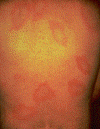Contact Info
Lyme Disease Rashes
The Distinctive Rash
 The most common early sign of Lyme disease is an expanding skin rash called "erythema migrans." It begins as a reddened area near the tick bite. As the rash increases in size, it often clears in the middle and develops a red ring around the outside, so that it has a “bull's eye” appearance. It does not always look like a bull's eye, but it does expand in size. This rash:
The most common early sign of Lyme disease is an expanding skin rash called "erythema migrans." It begins as a reddened area near the tick bite. As the rash increases in size, it often clears in the middle and develops a red ring around the outside, so that it has a “bull's eye” appearance. It does not always look like a bull's eye, but it does expand in size. This rash:
- May expand to a very large size.
- Is usually not painful or itchy.
- Often appears on the thighs, groin, trunk and armpit.
- The rash has been reported in about 60 to 80 percent of Lyme disease cases.
- Not everyone with Lyme disease gets the rash.
- Sometimes the rash does not have a bull's eye appearance. It may appear as a reddened area without an outer ring.
- The Lyme disease rash is not transmitted from person to person.
The early signs and symptoms of Lyme disease (fever, chills, headache, muscle/joint pain and fatigue) are similar to other ailments. Therefore, it may be difficult to diagnose Lyme disease if a person does not have the rash.
Multiple Rashes
 A person may experience multiple rashes, such as those you see here. The rash is not caused from multiple tick bites, but occurs as a reaction when the bacteria moves through the body.
A person may experience multiple rashes, such as those you see here. The rash is not caused from multiple tick bites, but occurs as a reaction when the bacteria moves through the body.
More information
CDC: Lyme Disease Rashes and Look-alikes
Pictures of Lyme disease rashes and rashes that look similar.